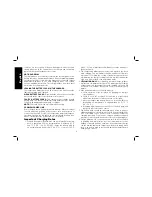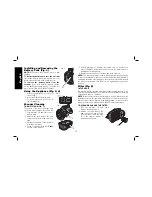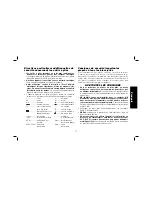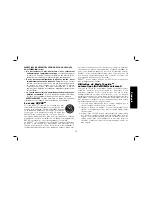
Important Safety Instructions for All
Battery Chargers
SAVE THESE INSTRUCTIONS:
This manual contains important
safety and operating instructions for battery chargers.
• Before using the charger, read all instructions and cautionary
markings on the charger, battery pack and product using the
battery pack.
DANGER:
Electrocution hazard. 120 volts are present at recessed
terminals of the tower port. Do not probe with conductive objects.
Electric shock or electrocution may result.
WARNING:
Shock hazard. Do not allow any liquid to get inside the
charger. Electric shock may result.
CAUTION:
Burn hazard. To reduce the risk of injury, charge only
D
E
WALT rechargeable battery packs. Other types of batteries may
overheat and burst resulting in personal injury and property damage.
NOTICE:
Under certain conditions, with the charger plugged into
the power supply, the charger can be shorted by foreign material.
Foreign materials of a conductive nature, such as, but not limited to,
grinding dust, metal chips, steel wool, aluminum foil or any buildup
of metallic particles should be kept away from the charger cavities.
Always unplug the charger from the power supply when there is no
battery pack in the cavity. Unplug the charger before attempting to
clean it.
•
DO NOT attempt to charge the battery pack with any
chargers other than the ones in this manual.
The charger and
battery pack are specifically designed to work together.
•
These chargers are not intended for any uses other than
charging D
E
WALT rechargeable batteries.
Any other uses
may result in risk of fire, electric shock or electrocution.
•
Do not expose the charger to rain or snow.
•
Pull by the plug rather than the cord when disconnecting
the charger.
This will reduce the risk of damage to the electric
plug and cord.
•
Make sure that the cord is located so that it will not be
stepped on, tripped over or otherwise subjected to damage
or stress.
•
Do not use an extension cord unless it is absolutely
necessary.
Use of improper extension cord could result in risk of
fire, electric shock or electrocution.
•
When operating a charger outdoors, always provide a dry
location and use an extension cord suitable for outdoor use.
Use of a cord suitable for outdoor use reduces the risk of electric
shock.
•
An extension cord must have adequate wire size (AWG
or American Wire Gauge) for safety.
The smaller the gauge
number of the wire, the greater the capacity of the cable, that is,
16 gauge has more capacity than 18 gauge. An undersized cord
will cause a drop in line voltage resulting in loss of power and
overheating. When using more than one extension to make up the
total length, be sure each individual extension contains at least the
minimum wire size. The following table shows the correct size to
use depending on cord length and nameplate ampere rating. If in
doubt, use the next heavier gauge. The lower the gauge number,
the heavier the cord.
Minimum Gauge for Cord Sets
Ampere
Rating
Volts
Total Length of Cord in Feet (meters)
120V
25 (7.6)
50 (15.2)
100 (30.5) 150 (45.7)
240V
50 (15.2) 100 (30.5)
200 (61.0) 300 (91.4)
More
Than
Not
More
Than
AWG
0
6
18
16
16
14
6
10
18
16
14
12
10
12
16
16
14
12
12
16
14
12
Not Recommended
English
6
Summary of Contents for DCV580
Page 2: ......









































